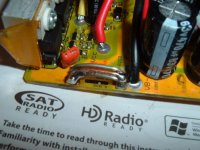wesnewell said:
I've got a 48V controller that draws about 30A and gets 25+mph using a GM 500W rear hub. I've ordered a cheap 72V controller to try on it, but am thinking about modding the shunts on the 48V one I have now. It has pads for 3 shunts, but only 2 are used. I want to get ~40A draw from the controller, but while I'm at it, I'd like to add a toggle to effectively limit the amps by running one of the shunts through the switch. Does this sound right?
As long as the switch is low-resistance, too, then it should work, but it's possible for a switch to be higher resistance than a shunt, so it won't end up the total resistance you expect.
Also, it will increase as the switch gets hotter from current passing thru it; remember that in theory, assuming the shunts were all equal value, the switched one would see 1/3 of your total battery current flowing thru it at any instant. Since the switch will add some resistance, possibly double it, it may only see 1/4 or less, but that's still a lot at high loads.

How many FETs does your 48V controller have, and what kind are they? I'd guess it's a 12FET for 30A (assuming constant), as that seems about right for both of the 12FETs I have here. 40A is a third more than original, whcih is a lot. My 12FETs will allow up to 60A momentarily, but not for long (a second or two?), just as I start from a stop. Haven't tested it on a steep hill yet, under high throttle (I try to avoid those).
Too few FETs with too low a rating could end up blowing some, running at 40A continous; I'm not sure what rating you need for this, as it depends on the phase currents they see (very different from the battery currents, which is what the shunt measures).



